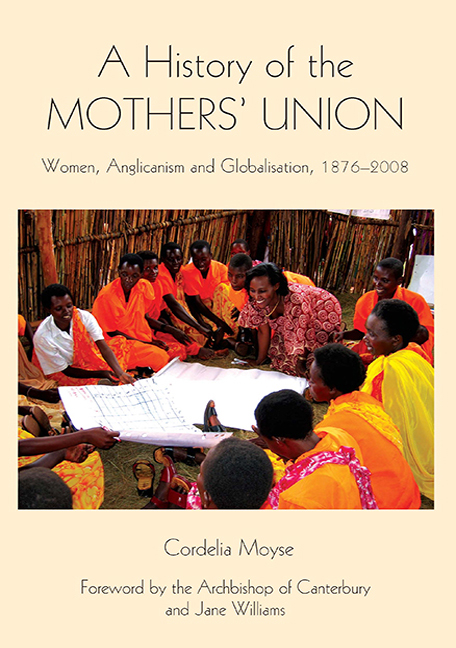Book contents
- Frontmatter
- Contents
- Dedication
- List of Illustrations
- Foreword by the Archbishop of Canterbury and Jane Williams
- Acknowledgements
- Abbreviations
- Introduction
- Part I 1876–1909
- 1 Launching the Mothers’ Union
- 2 Identity and Spirituality
- 3 Marriage and Family Life
- 4 Membership and Worldwide Work
- Part II 1910–1944
- Part III 1945–1974
- Part IV 1975–2008
- Conclusion
- Appendix 1 Text of early membership cards
- Appendix 2 Development of the Mothers' Union prayer
- Appendix 3 Midday prayers (original)
- Appendix 4 Development of the objects
- Appendix 5 Biographical notes on central and worldwide presidents
- Bibliography
- Index
- Miscellaneous Endmatter
4 - Membership and Worldwide Work
from Part I - 1876–1909
Published online by Cambridge University Press: 29 April 2017
- Frontmatter
- Contents
- Dedication
- List of Illustrations
- Foreword by the Archbishop of Canterbury and Jane Williams
- Acknowledgements
- Abbreviations
- Introduction
- Part I 1876–1909
- 1 Launching the Mothers’ Union
- 2 Identity and Spirituality
- 3 Marriage and Family Life
- 4 Membership and Worldwide Work
- Part II 1910–1944
- Part III 1945–1974
- Part IV 1975–2008
- Conclusion
- Appendix 1 Text of early membership cards
- Appendix 2 Development of the Mothers' Union prayer
- Appendix 3 Midday prayers (original)
- Appendix 4 Development of the objects
- Appendix 5 Biographical notes on central and worldwide presidents
- Bibliography
- Index
- Miscellaneous Endmatter
Summary
Both the initial Victorian expansion of the MU throughout the British Isles and its emergence and growth across the world were unplanned. Branches sprang up around the Empire and beyond, wherever the female relatives of clergy, colonists, civil servants and soldiers planted them. In the early years overseas branches were initially formed to serve the spiritual needs of expatriate women and those colonist women of British descent who often felt isolated from their ‘mother country’. The variety of political, social and religious contexts in which women joined the MU was immense. Branches were established in the former penal colonies of Australia; the multi-faith Indian Empire; outside British rule in China and Madagascar; as well as in the military outposts of Gibraltar and Malta.
Yet another wave of unplanned growth ensured the expansion of the MU overseas around the turn of the twentieth century. The MU would now be taken up as a model for female Christian discipleship by those engaged in the missionary field. Now in addition to branches of female relatives of white colonists or imperial administrators there were branches of ‘native’ indigenous women. It was against this background, and in the light of contemporary thinking about Britain's imperial role and that of the Anglican Church within the Empire, that the MU corporately sought to articulate its understanding of its mission to home and family. One consequence was that it moved from simply acquiring new members overseas to articulating a vision of a worldwide mission and taking deliberate actions aimed at increasing membership across the Empire.
The first section in this chapter looks briefly at why and how the seeds of the MU were planted outside the British Isles before 1896. The second considers the context and content of MU thinking which contributed to the sustained creation of branches and diocesan organisations overseas after 1896 when the MU drew up its first central constitution. It shows how the MU came to see itself as having an imperial vocation and accordingly laid the foundations for further overseas growth.
Two case studies of the early development of the MU in Australia and South Africa are illustrative. They demonstrate that expansion overseas did not simply involve the adoption of the Winchester or English model. Branches emerged in a variety of contexts and forced the MU to adapt to meet differing social and religious needs.
- Type
- Chapter
- Information
- A History of the Mothers' UnionWomen, Anglicanism and Globalisation, 1876–2008, pp. 78 - 94Publisher: Boydell & BrewerPrint publication year: 2009



